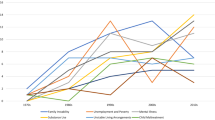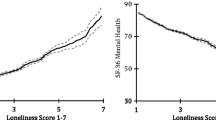Abstract
The purpose of this research study was to examine the relationship between race, ethnicity, foreign-born status, and social capital among single women who use welfare. It was hypothesized that the utilization of various types of social capital would vary by group. This study analyzed Wave 2 (2005–2007) data from the Making Connections Cross-Site Survey database. 1,428 women with no spouse/partner present in the household who indicated use of a TANF/welfare office in the last 12 months were selected for inclusion in the study sample. Structural equation modeling was used to answer this study’s research question. Black women had a higher level of bridging, support giving, and support receiving social capital. Hispanic women had a lower level of bridging social capital. Foreign-born women had a higher level of bonding and value sharing social capital. Implications for policy, social work practice, and research are discussed.


Similar content being viewed by others
References
Alfred, M. V. (2009). Social capital theory: Implications for women’s networking and learning. In C. R. Nanton & M. V. Alfred (Eds.), Social capital and women’s support systems: Networking, learning, and surviving (pp. 3–12). Danvers, MA: Wiley Periodicals, Inc.
Alfred, M. V., & Nanton, C. R. (2009). Survival of the supported: Social capital networks and the finish line. In C. R. Nanton & M. V. Alfred (Eds.), Social capital and women’s support systems: Networking, learning, and surviving (pp. 83–94). Danvers, MA: Wiley Periodicals, Inc.
Bollen, K. A. (1989). Structural equations with latent variables. New York: Wiley.
Brisson, D., Roll, S., & East, J. (2009). Race and ethnicity as moderators of neighborhood bonding social capital: Effects on employment outcomes for families living in low-income neighborhoods. Families in Society: The Journal of Contemporary Social Science, 90(4), 368–374.
Carpiano, R. M. (2008). Actual or potential neighborhood resources for health: What can Bourdieu offer for understanding mechanisms linking social capital to health? In I. Kawachi, S. V. Subramanian, & D. Kim (Eds.), Social capital and health (pp. 83–94). New York: Springer.
Centre for Educational Research and Innovation. (2001). The well-being of nations: The role of human and social capital. Paris: Organisation for Economic Co-Operation and Development.
Curley, A. M. (2010). Relocating the poor: Social capital and neighborhood resources. Journal of Urban Affairs, 32(1), 79–103.
DeVellis, R. F. (2003). Scale development: Theory and applications (2nd ed.)., Applied social research methods series, 26 Thousand Oaks, CA: Sage Publications, Inc.
Edin, K., & Lein, L. (1997). Making ends meet. New York: Russell Sage Foundation.
Flap, H. D. (1991). Social capital in the reproduction of inequality. Comparative Sociology of Family, Health and Education, 20, 6179–6202.
Gidengil, E., & O’Neill, B. (2006). Removing rose colored glasses: Examining theories of social capital through a gendered lens. In B. O’Neill & E. Gidengil (Eds.), Gender and social capital (pp. 1–14). New York: Routledge.
Halpern, D. (2005). Social capital. Cambridge: Polity Press.
Harpham, T. (2008). The measurement of community social capital through surveys. In I. Kawachi, S. V. Subramanian, & D. Kim (Eds.), Social capital and health (pp. 51–62). New York: Springer.
Hu, L., & Bentler, P. M. (1999). Cutoff criteria for fit indexes in covariance structure analysis: Conventional criteria versus new alternatives. Structural Equation Modeling, 6, 1–55.
Jennings, J. (2007). Social capital, race, and the future of inner-city neighborhoods. In J. Jennings (Ed.), Race, neighborhoods, and the misuse of social capital (pp. 87–108). New York: Palgrave Macmillan.
Kaiser, H. F. (1960). The application of electronic computers to factor analysis. Educational and Psychological Measurement, 20, 141–151.
Kaiser, H. F. (1974). An index of factorial simplicity. Psychometrika, 39, 31–36.
Lin, N. (2001). Social capital: A theory of social structure and action. Cambridge: Cambridge University Press.
Lowndes, V. (2000). Women and social capital: A comment on ‘Hall’s Social Capital in Britain’. British Journal of Political Science, 30(3), 533–537.
Lowndes, V. (2006). It’s not what you’ve got, but what you do with it: Women, social capital, and political participation. In B. O’Neill & E. Gidengil (Eds.), Gender and social capital (pp. 213–240). New York: Routledge.
Putnam, R. D. (2000). Bowling alone: The collapse and revival of American community. New York: Simon & Schuster.
Schafer, J. L. (1999). Multiple imputation: A primer. Statistical Methods in Medica Research, 8(1), 3–15.
Schneider, J. A. (2006). Social capital and welfare reform. New York: Columbia University Press.
Schumacker, R. E., & Lomax, R. G. (2004). A beginner’s guide to structural equation modeling (2nd ed.). Mahwah, NJ: Lawrence Erlbaum Associates.
Smith, S. S., & Kulynych, J. (2007). Social capital, the sow’s ear, and the closing of the political universe. In J. Jennings (Ed.), Race, neighborhoods, and the misuse of social capital (pp. 41–66). New York: Palgrave Macmillan.
The Annie E. Casey Foundation. (2009). Invitation to apply for access to the Making Connections Cross-Site Survey database.
Whitley, R. (2008). Social capital and public health: Qualitative and ethnographic approaches. In I. Kawachi, S. V. Subramanian, & D. Kim (Eds.), Social capital and health (pp. 95–115). New York: Springer.
Author information
Authors and Affiliations
Corresponding author
Rights and permissions
About this article
Cite this article
Gezinski, L.B. Examining the Relationship Between Race, Ethnicity, Foreign-Born Status, and Social Capital Among Women on Public Assistance. Soc Indic Res 115, 9–21 (2014). https://doi.org/10.1007/s11205-012-0206-6
Accepted:
Published:
Issue Date:
DOI: https://doi.org/10.1007/s11205-012-0206-6




